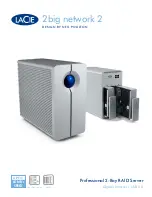
35
2. If one drive fails in RAID 1/5, up to two drives fail in RAID 6/RAID 10*, the storage pool
status will be labeled as “Degraded” and the Volume/RAID group status should be
labeled as “Warning”.
3. Go to “Storage Manager” > “Storage” > “Disks/VJBOD” to determine which disk needs
to be replaced.
4. Take out bad drive from NAS enclosure and remove the drive from the tray.
5. Install replacement drive onto tray.
Note: the capacity of the new drive must be equal to or greater than the capacity of the
old drive.
7. Insert tray with drive installed into NAS.
Important: Wait for two beeps after removing the faulty drive before inserting
replacement drive into NAS. The NAS should also beep twice after replacement drive is
installed.
8. The volume should automatically rebuild. Go to “Storage Manager” > “Storage” >
“Storage Space” to confirm.
6.4 RAID Recovery - Accidental Removal of a Healthy Drive
The QNAP NAS supports RAID recovery when a healthy drive is unexpectedly removed from
a RAID 1/5/6 during hot-swapping or RAID 0/JBOD configuration in QTS. Note that RAID 10
does not support this feature.
When a healthy drive is unexpectedly removed from a RAID group, the status of the RAID
will change to “Not active”. To recover from an “Not active” status:
1. Re-insert all drives back into the NAS in its original order. This includes any bad drive(s)
that will need to be replaced after recovery.
2. Log into QTS as administrator and go to “Storage Manager” > “Storage” > “Storage
Space”.
3. Double click on the affected Storage Pool to open the Storage Pool Management
window.
















































